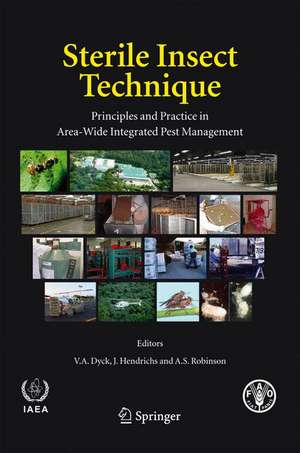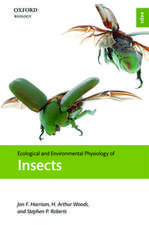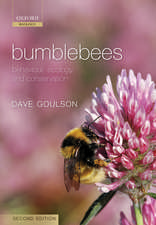Sterile Insect Technique: Principles and Practice in Area-Wide Integrated Pest Management
Editat de V.A. Dyck, J. Hendrichs, A.S. Robinsonen Limba Engleză Hardback – 29 noi 2005
| Toate formatele și edițiile | Preț | Express |
|---|---|---|
| Paperback (1) | 1839.63 lei 6-8 săpt. | |
| SPRINGER NETHERLANDS – 16 sep 2014 | 1839.63 lei 6-8 săpt. | |
| Hardback (1) | 1844.67 lei 6-8 săpt. | |
| SPRINGER NETHERLANDS – 29 noi 2005 | 1844.67 lei 6-8 săpt. |
Preț: 1844.67 lei
Preț vechi: 2249.60 lei
-18% Nou
Puncte Express: 2767
Preț estimativ în valută:
353.09€ • 383.66$ • 296.79£
353.09€ • 383.66$ • 296.79£
Carte tipărită la comandă
Livrare economică 21 aprilie-05 mai
Preluare comenzi: 021 569.72.76
Specificații
ISBN-13: 9781402040504
ISBN-10: 1402040504
Pagini: 804
Ilustrații: XIV, 787 p.
Dimensiuni: 160 x 240 x 48 mm
Greutate: 1.25 kg
Ediția:2005
Editura: SPRINGER NETHERLANDS
Colecția Springer
Locul publicării:Dordrecht, Netherlands
ISBN-10: 1402040504
Pagini: 804
Ilustrații: XIV, 787 p.
Dimensiuni: 160 x 240 x 48 mm
Greutate: 1.25 kg
Ediția:2005
Editura: SPRINGER NETHERLANDS
Colecția Springer
Locul publicării:Dordrecht, Netherlands
Public țintă
ResearchCuprins
History of the Sterile Insect Technique.- Principles of the Sterile Insect Technique.- Area-Wide Integrated Pest Management and the Sterile Insect Technique.- Biological Basis of the Sterile Insect Technique.- Genetic Basis of the Sterile Insect Technique.- Inherited Sterility in Insects.- Mathematical Models for the Use of Sterile Insects.- Technical Components of the Sterile Insect Technique.- Role of Population and Behavioural Ecology in the Sterile Insect Technique.- Mass-Rearing for Sterile Insect Release.- Sterilizing Insects with Ionizing Radiation.- Sterile Insect Quality.- Sterile Insect Supply, Emergence, and Release.- Monitoring Sterile and Wild Insects in Area-Wide Integrated Pest Management Programmes.- Procedures for Declaring Pest Free Status.- Supportive Technologies to Improve the Sterile Insect Technique.- Role of Population Genetics in the Sterile Insect Technique.- Population Suppression in Support of the Sterile Insect Technique.- Genetic Sexing Strains in Mediterranean Fruit Fly, an Example for Other Species Amenable to Large-Scale Rearing for the Sterile Insect Technique.- Use of Geographic Information Systems and Spatial Analysis in Area-Wide Integrated Pest Management Programmes that Integrate the Sterile Insect Technique.- Economic, Environmental, and Management Considerations.- Application of Benefit/Cost Analysis to Insect Pest Control Using the Sterile Insect Technique.- Environment and the Sterile Insect Technique.- Management of Area-Wide Integrated Pest Management Programmes that Integrate the Sterile Insect Technique.- Public Relations and Political Support in Area-Wide Integrated Pest Management Programmes that Integrate the Sterile Insect Technique.- Application of the Sterile Insect Technique.- Strategic Options in Using Sterile Insects for Area-Wide Integrated Pest Management.- Misconceptions and Constraints.- Impact of Area-Wide Integrated Pest Management Programmes That Integrate the Sterile Insect Technique.- Impact of Screwworm Eradication Programmes Using the Sterile Insect Technique.- Impact of Fruit Fly Control Programmes Using the Sterile Insect Technique.- Impact of Moth Suppression/Eradication Programmes Using the Sterile Insect Technique or Inherited Sterility.- Potential Impact of Tsetse Fly Control Involving the Sterile Insect Technique.- Future Development of the Sterile Insect Technique.- Prospects for the Future Development and Application of the Sterile Insect Technique.
Recenzii
From the reviews:
"Integrated pest management (IPM) requires the use of all available tools to manage pests. Sterile Insect Technique (SIT) exhaustively reviews the principles and practices of SIT in area-wide IPM. ... this book thoroughly reviews the history, application, successes and failures of SIT, and its value as a component of area-wide IPM. ... the application of newer technologies to area-wide IPM makes this an outstanding international contribution to IPM. Summing Up: Highly recommended. Upper-division undergraduates and above; general readers." (R. Frederiksen, CHOICE, Vol. 43 (10), June, 2006)
"Integrated pest management (IPM) requires the use of all available tools to manage pests. Sterile Insect Technique (SIT) exhaustively reviews the principles and practices of SIT in area-wide IPM. ... this book thoroughly reviews the history, application, successes and failures of SIT, and its value as a component of area-wide IPM. ... the application of newer technologies to area-wide IPM makes this an outstanding international contribution to IPM. Summing Up: Highly recommended. Upper-division undergraduates and above; general readers." (R. Frederiksen, CHOICE, Vol. 43 (10), June, 2006)
Textul de pe ultima copertă
The sterile insect technique (SIT) is an environment-friendly method of pest control that integrates well into area-wide integrated pest management (AW-IPM) programmes. A first of its kind, this book takes a generic, comprehensive, and global approach in describing the principles and practice of the SIT. The strengths and weaknesses, and successes and failures, of the SIT are evaluated openly and fairly from a scientific perspective. The SIT is applicable to some major pests of plant, animal and human health importance, and criteria are provided to guide in the selection of pests appropriate for the SIT.
A great variety of subjects are covered, from the history of the SIT to improved prospects for its future application. The major chapters discuss the principles, technical components, and application of sterile insects. The four main strategic options in using the SIT — suppression, containment, prevention, and eradication — with examples of each option, are described in detail. Other chapters deal with supportive technologies, economic, environmental, and management considerations, and the socio-economic impact of AW-IPM programmes that integrate the SIT.
This book provides a wealth of information and reference material never before available in one volume. It will be a standard reference on the subject for many years. The authors, from 19 countries, are highly experienced in the subject, and reflect the international character of SIT activities.
Since no university offers courses on the SIT, the book’s audience will be mainly students in general animal and plant health courses, but the in-depth reviews of all aspects of the SIT and its integration into AW-IPM programmes will be of great value to researchers, teachers, animal and plant health practitioners, and policy makers.
A great variety of subjects are covered, from the history of the SIT to improved prospects for its future application. The major chapters discuss the principles, technical components, and application of sterile insects. The four main strategic options in using the SIT — suppression, containment, prevention, and eradication — with examples of each option, are described in detail. Other chapters deal with supportive technologies, economic, environmental, and management considerations, and the socio-economic impact of AW-IPM programmes that integrate the SIT.
This book provides a wealth of information and reference material never before available in one volume. It will be a standard reference on the subject for many years. The authors, from 19 countries, are highly experienced in the subject, and reflect the international character of SIT activities.
Since no university offers courses on the SIT, the book’s audience will be mainly students in general animal and plant health courses, but the in-depth reviews of all aspects of the SIT and its integration into AW-IPM programmes will be of great value to researchers, teachers, animal and plant health practitioners, and policy makers.
Caracteristici
A standard reference on the subject for many years to come The authors, from 19 countries, are highly experienced in the subject, and reflect the international character of SIT activities














